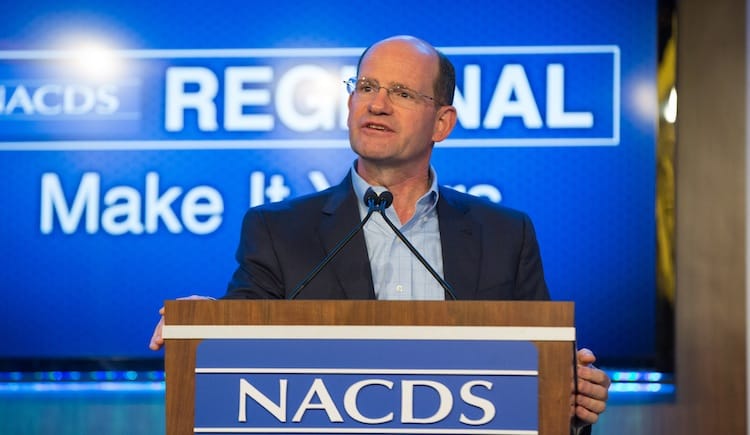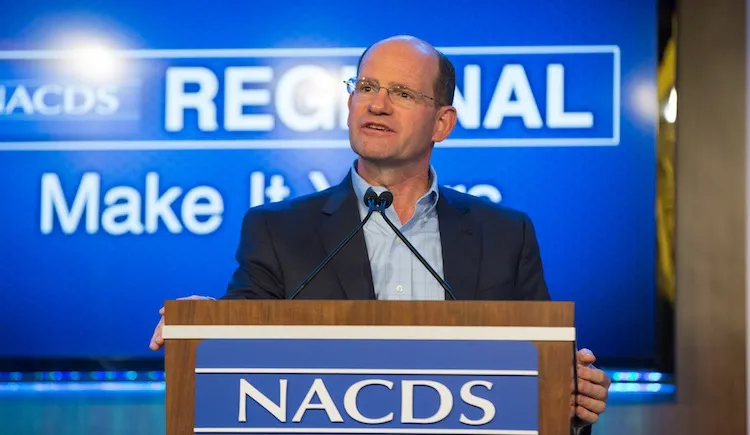
Eric Graf of Ritzman Pharmacies at the NACDS Regional Chain Conference, for which he served as chairman.
FORT LAUDERDALE, Fla. — Stakeholders in chain pharmacy understandably direct a lot of attention to the giants of the industry, such companies as CVS Health, Walgreens Boots Alliance, McKesson and Kroger. They shouldn’t lose sight, however, of the regional players that, in the aggregate, still account for a substantial part of the business and remain an important source of fresh thinking and innovation.
The dynamism of that sector, comprised of retailers that operate between four and 250 stores, was readily apparent at the National Association of Chain Drug Stores Regional Chain Conference, which unfolded over three days earlier this month at the Fort Lauderdale Marriott Harbor Beach Resort and Spa. The event was notable in several respects.
It attracted a record number of retailers, 44 companies that together run some 2,300 stores and generate more than $11 billion a year in sales, and 75 suppliers, including such heavy hitters as Bayer Consumer Health, Mondelez International and Teva Pharmaceuticals. More important, the meeting provided regional pharmacy chains with a forum to examine their place in the market and exchange ideas about the best ways to meet the evolving needs of customers and, in the process, maintain their viability.
That is no easy task. Relentless consolidation within the industry over the past 25 years, coupled with a growing number of forays into other parts of health care, has left the biggest pharmacy operators with annual sales in excess of $100 billion apiece. In a business where economies of scale and buying power are viewed as a good way to counter downward pressure on profit margins, regional chains find themselves at a disadvantage. The disparity in scale can also make it more difficult for regionals to secure inclusion in third-party payers’ pharmacy networks and fully leverage traditional marketing tools to build brand recognition.
Despite the very real challenges, the leaders of the nation’s regional pharmacy chains exuded a sense of purpose and confidence at the NACDS Regional Chain Conference. Eric Graf, chief executive officer of Ritzman Pharmacies and chairman of the event, set the tone.
“This conference makes a difference,” he said at the opening session. “This conference is about sharing, collaboration and discussion on the issues and opportunities, now and in the future. The value realized by the conference is directly proportional to the amount of effort we put into each of our interactions this week.”
The willingness of attendees to get involved was exemplified by Graf himself. In addition to serving as conference chairman, he gave a 45-minute presentation, “Redefining the Community Pharmacy Experience,” during which he detailed Ritzman’s ambitious effort to transform its stores into “practices” where the expertise of the company’s pharmacists and an enhanced customer experience are front and center, and led a subsequent breakout session that expanded on those themes.
While in some respects unique, the ongoing work at Ritzman reflects broader trends among regional pharmacy chains, most of whose leaders recognize that business as usual isn’t an option. The talk among executives involved discussion of the importance of capitalizing on assets — their intimate knowledge of the communities they serve and nimbleness in reacting to emerging opportunities, among them — that national competitors are hard pressed to replicate, and the value of partnerships with other health care providers and, in some instances, retailers in other trade channels.
As at most NACDS gatherings, government affairs were high on the agenda. Attendees were given a thorough overview of legislative and regulatory issues facing pharmacy at the federal and state levels. The association once again demonstrated its knack for staying on top of developments, amending the conference schedule after the federal government published the final rule on reimbursements to pharmacies under Medicaid. The regulations, among other things, alter the formula based on average manufacturer prices, or AMPs, for determining payments for generic drugs.
“There is going to be a lot of discussion about the new Medicaid AMP rule,” said Randy Edeker, who is current chairman of the association and chairman, president and CEO of Hy-Vee. “Regarding NACDS’ track record on this issue, the association has demonstrated great leadership in advocating for pharmacy and for patients. It is a very tough issue, and NACDS will have a very critical eye. Looking back, the success of NACDS and our allies in blocking the original approach to Medicaid AMP prevented the forced closure of 11,000 pharmacies — 20% of all stores.”
Executives were briefed on NACDS’ initial analysis of the new rule and heard about the association’s ongoing systematic evaluation of its implications and preparations for developing an appropriate response.
The regional chain conference showed NACDS at its best, serving, in the formulation of association president and CEO Steve Anderson, as the nexus between business and government, a function particularly important for retailers that don’t have a permanent presence in Washington. By bringing its unmatched strengths in government affairs, communications and member services to bear, NACDS remains a significant contributor to the health of regional pharmacy chains and the broader industry where they continue to find new ways to compete and flourish.







